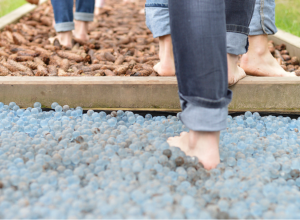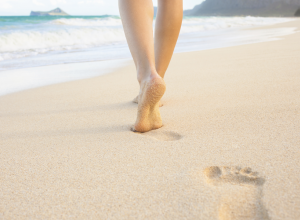
Barefoot Parks
Barefoot parks are parks designed for barefoot walking and playing. Sometimes called barefoot trails and barefoot walks, the public spaces provide people the opportunity to feel the ground and other various materials with their bare feet, said to help strengthen foot and leg muscles. Most barefoot parks are located in Europe, with Germany and Austria having the highest number of the quirky attraction.
Why Go Barefoot?
Walking barefoot, sometimes called earthing, is the process of walking on natural substances like grass, sand and mud. Not only does walking and engaging in light athletic activities with bare soles increase circulation and help strengthen foot and leg muscles, it is said that when the feet come into direct contact with the electrons present on the Earth’s surface, the electrons can influence the body’s bioelectrical process, thereby decreasing stress and increasing overall wellness.
Additionally, many podiatrists and foot experts agree that wearing shoes can actually be detrimental to foot health and cause foot problems and deformities like Achilles tendonitis, bunions, calluses, corns, gait problems, hammertoes and flat feet. The reason is because shoes interfere with a person’s natural way of walking, running and jumping, and the muscles in the feet and legs actually weaken and begin depending on shoes for strength and support. Going barefoot helps train the muscles in the legs and feet to work as they were naturally intended to work rather than being dependent on shoes for support. And believe it or not, this can actually dramatically reduce back, knee and hip pain. (For more information on how barefoot activities can improve bodily health, check out our article on Barefoot Running.)
Furthermore, walking barefoot on various types of surfaces can provide a (free!) stimulating massage for your feet.
What Can One Expect To Find At A Barefoot Park?
Barefoot parks — called Barfußparks in German — provide the perfect playground for safe, healthy barefoot walking. They normally provide a foot washing station for both before and after the experience, as well as several barefoot attractions laid out like an obstacle course. They include:
- Walking paths made from various materials like river stones, mulch and sand
- Barefoot bridges
- Balancing equipment
- Climbing stations
- Mud slides
- Mud paths
- Water wading paths
- Stairs
- Ladders
- Nature trails
Barefoot Park Do’s and Don’ts
The average cost of entering a barefoot park is usually $2 or under, with many being free. The best time to visit is between May and September.
Barefoot Park Do’s
- Wear shorts or pants that you can roll up over the knees
- Wear comfortable clothes you don’t mind getting dirty
- Bring a towel to dry your feet after using the washing station
- Maintain a sense of fun and adventure
Barefoot Park Don’ts
- Do not wear jewelry or other accessories that may be easily lost
- Do not wear expensive shoes, as your feet may still be a bit dirty even after washing
Where Can I Find a Barefoot Park?
Most barefoot parks are located in Germany and Austria, but they can also be found in Denmark, France, Hungary, Switzerland and the United Kingdom. Some of the most famous barfußparks in Germany include Barfußpfad Bad Sobernheim, Barfusspark Dornstetten Hallwangen, Offenburg Zell Weierbach, Todtnau Muggenbrunn and Gutach.
Notice concerning medical entries:
Articles having medical content shall serve exclusively for the purpose of general information. Such articles are not suitable for any (self-) diagnosis and treatment of individual illnesses and medical indications. In particular, they cannot substitute for the examination, advice, or treatment by a licensed physician or pharmacist. No replies to any individual questions shall be effected through the articles.







